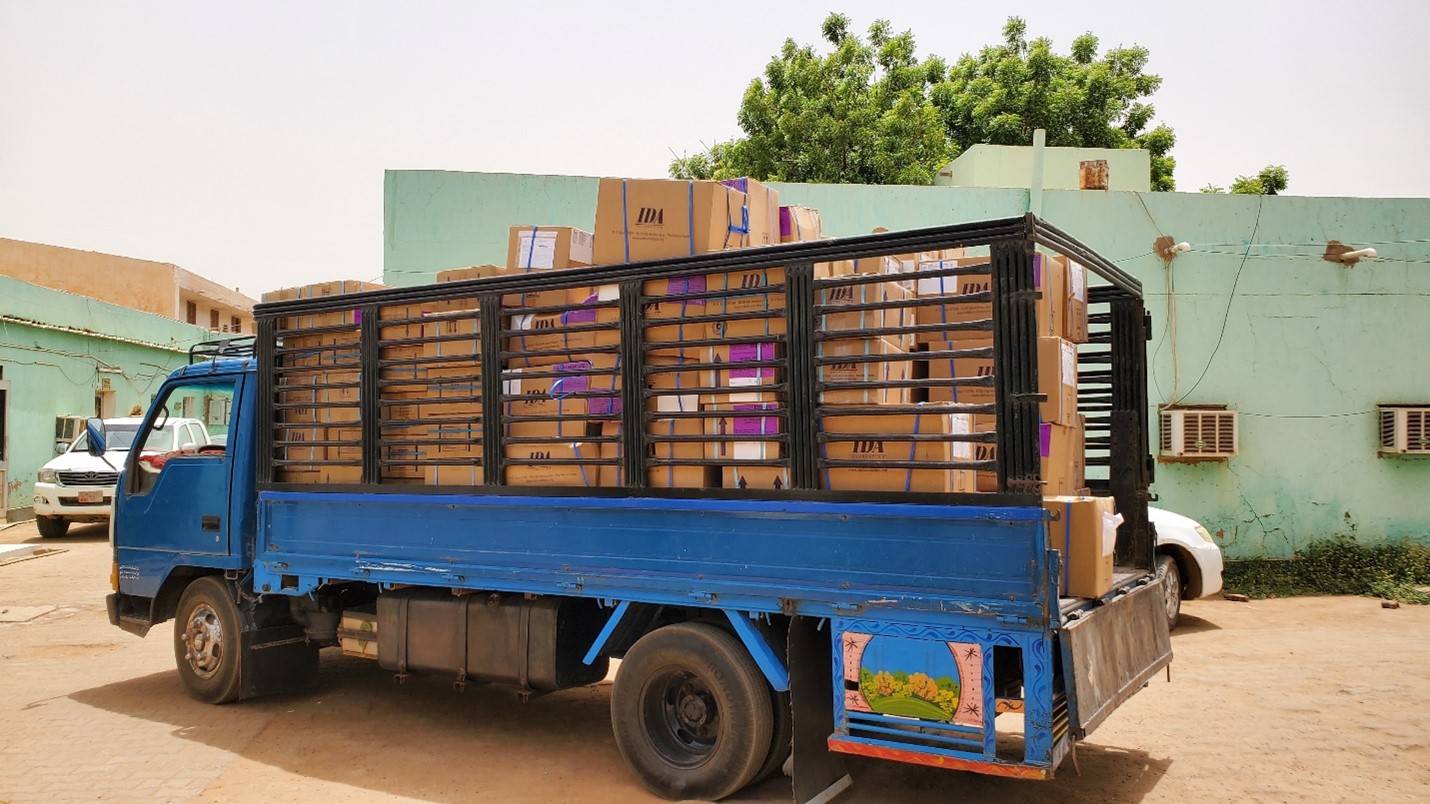
The WHO Country Office in Sudan delivering a shipment of essential medicines for inpatient management of wasting in Khartoum.
© WHO / Ansari, Aurangzaib
Malnutrition in children under five years old and among women has been a public health problem in Sudan for the past three decades, leading to wasting, stunting, increased vulnerability to infectious and noncommunicable diseases, reduced quality of life, and increased risk of early death. Malnutrition is associated not only with poor physical development but also poor mental development. Wasting and stunting are fundamental determinants of health and are entirely preventable. While the overall trend for wasting and stunting in Sudan shows a decline, the results of Sudan’s 2018 Simple, Spatial, Survey Method (S3M II) revealed that one in seven under-five children were wasted (13.6%) and one in three children were stunted (36.4%). Nutrition surveillance allows early warning, prevention and management of all forms of malnutrition. WHO’s strategic investments in building and sustaining a fully functional nutrition surveillance system in Sudan is estimated to benefit 1.8 million children and women annually, accelerating progress toward 2030 targets.
How did Sudan do it? How did WHO support Sudan?
A robust national nutrition information system is essential for collecting timely, regular and quality disaggregated data to assess nutrition status, identifying at-risk groups, and developing evidence-based policies. It guides decision-making to ensure efficient and effective allocation of resources, monitors implementation of actions, and evaluates outcomes to determine progress toward the achievement of goals and targets and reach those most in need.
By building on the existing Health Information System. Through a consultative process, the Ministry of Health, together with WHO and partners, agreed to build on the existing Health Information System (HIS) to integrate nutrition indicators and strengthen the quality of data inputs. A continuous data quality monitoring feedback mechanism allows timely detection and reporting of data issues by Ministry of Health officials in all states.
By refining nutrition indicators, identifying sources of data, and developing methods for analysis and reporting. The Ministry of Health, with WHO support, refined nutrition indicators, identified sources of data, and developed methods for analysis and reporting.
By aggregating data from multiple databases for comprehensive analysis. Data from three databases—Severe Acute Malnutrition (SAM), Targeted Supplementary Feeding Program (TSFP), and Growth Monitoring Database—were used for integrated analysis of nutrition-specific and nutrition-sensitive indicators to support comprehensive analysis of nutrition status and the management of severe wasting.
By investing in capacity building for nutrition surveillance and reporting. WHO trained 139 health workers through seven five-day nutrition surveillance and database management training sessions. As a result, trained health workers develop and publish surveillance reports (bulletins) which include national and subnational-level data. Bulletins, which include data from all states, are disseminated to nutrition partners on a quarterly and annual basis.
By developing guidance documentation. A data registration, reporting and planning manual for nutrition staff was developed and pre-tested in Khartoum state. In addition, a checklist was developed to improve community management of acute malnutrition. It was tested in two states, in stabilization centers, outpatient treatment programmes, and in targeted supplementary feeding programmes prior to approval by the Ministry of Health. The checklist is used in practice in all states.
By forecasting and supply planning for nutrition commodities. The Community Management of Acute Malnutrition (CMAM) report, which includes calculations of nutrition commodities, was revised to include more accurate calculations of nutrition supply needs to prevent shortages.
By developing a national global action plan roadmap. In 2021, the Ministry of Health of Sudan, together with WHO and other United Nations agencies, developed a national global action plan roadmap to improve the prevention and treatment of wasting in Sudan.
By strengthening infrastructure and capacity for the management of wasting. WHO provided 18 training sessions on the inpatient management of wasting to 492 health workers. The WHO Country Office in Sudan provided 1496 kits for the management of severe acute malnutrition in 144 nutrition centres. Anthropometric measurement equipment— mid-upper arm circumference measuring tapes, infant hanging scales, length/height measurement boards—was provided to 48 nutrition centres. Computer equipment (seven laptops and four desktops) was provided to the Ministry of Health.
By developing functional stabilization centers. WHO provided support to the Ministry of Health which led to the development of 144 functional stabilization centers which have provided treatment to approximately 30 000 wasted children with medical complications. The WHO Country Office in Sudan provided medical and laboratory supplies to 48 stabilization centers and renovated nine stabilization centres in various states. WHO also supported social mobilization activities to promote early detection, referral and treatment of severely wasted children in need of hospitalization.
Ending hunger, achieving food security and addressing malnutrition in all its forms is essential to ensure healthy lives and well-being for all. Nutrition surveillance provides a foundation for dialogue and the development of multisectoral discourse. To ensure a coordinated, coherent, and fit-for-purpose response, WHO closely collaborates with fellow United Nations agencies, non-State actors, communities, and the Government of Sudan to support community management of acute malnutrition along a multidimensional continuum of care.




